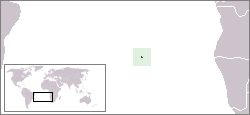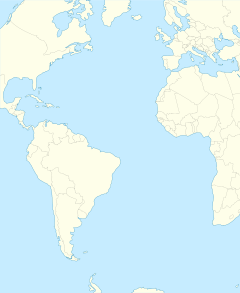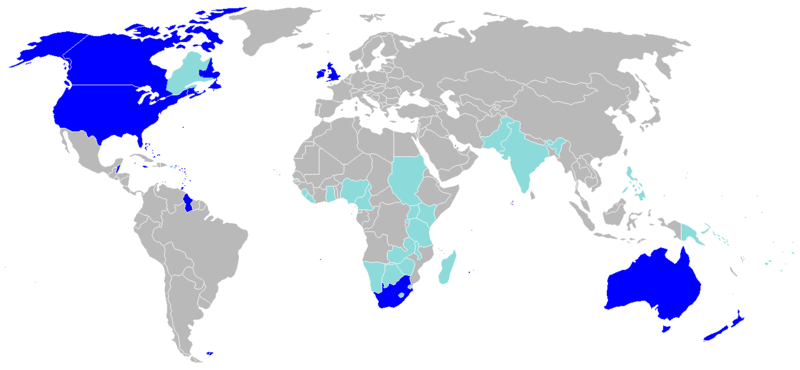| Saint Helena | ||||||
|---|---|---|---|---|---|---|
|
||||||
| Motto: "Loyal and Unshakeable" | ||||||
| Anthem: God Save the Queen My Saint Helena Island (unofficial) |
||||||
Location of Saint Helena in the South Atlantic Ocean.
|
||||||
| Capital | Jamestown | |||||
| Official languages | English | |||||
| Demonym | Saint Heleniana | |||||
| Government | British overseas territory | |||||
| - | Monarch | Elizabeth II | ||||
| - | Governor | Mark Andrew Capes | ||||
| Part of St Helena, Ascension & Tristan da Cunha | ||||||
| - | Charter granted | 1657 | ||||
| - | Colonised by the East India Company |
1659 |
||||
| - | Crown colony (Company rule ends) |
22 April 1834[1] |
||||
| - | Current constitution | 1 September 2009 | ||||
| Area | ||||||
| - | Total | 121 km2 47 sq mi |
||||
| Population | ||||||
| - | 2008 (Feb) census | 4,255[2] | ||||
| - | Density | 35/km2 90.6/sq mi |
||||
| Currency | Saint Helena pound (SHP) |
|||||
| Time zone | GMT (UTC+0) | |||||
| Drives on the | left | |||||
| Calling code | +290 | |||||
| Internet TLD | .sh | |||||
| a. | Or simply "Helenian". Informally, the islanders are also referred to as "Saints". | |||||
Saint Helena ( /ˌseɪnt həˈliːnə/ saynt-hə-LEE-nə), named after Saint Helena of Constantinople, is an island of volcanic origin in the South Atlantic Ocean. It is part of the British overseas territory of Saint Helena, Ascension and Tristan da Cunha[3] which also includes Ascension Island and the islands of Tristan da Cunha. Saint Helena measures about 16 by 8 kilometres (10 by 5 mi) and has a population of 4,255 (2008 census).[2]
The island was uninhabited when discovered by the Portuguese in 1502. It is one of the most isolated islands in the world. For centuries, it was an important stopover for ships sailing to Europe from Asia and South Africa. The British also used the island as a place of exile, most notably for Napoleon I, Dinuzulu kaCetshwayo and more than 5,000 Boer prisoners. Saint Helena is Britain's second oldest remaining colony (now termed overseas territory), after Bermuda.
History[]
Early history (1502–1658)[]
Most historical accounts state that the island was discovered on 21 May 1502 by the Spanish navigator João da Nova sailing at the service of the Portuguese Crown, and that he named it "Santa Helena" after Helena of Constantinople. Another theory holds that the island found by De Nova was actually Tristan da Cunha 2,430 kilometres (1,510 mi) to its south,[4] and that Saint Helena was discovered by some of the ships attached to the squadron of Estêvão da Gama expedition on 30 July 1503 (as reported in the account of clerk Thomé Lopes).[5][6][7]
The Portuguese found the island uninhabited, with an abundance of trees and fresh water. They imported livestock, fruit trees and vegetables, and built a chapel and one or two houses. Though they formed no permanent settlement, the island was an important rendezvous point and source of food for ships travelling from Asia to Europe.
Englishman Sir Francis Drake probably located the island on the final lap of his circumnavigation of the world (1577–1580).[8] Further visits by other English explorers followed, and, once Saint Helena’s location was more widely known, English ships of war began to lie in wait in the area to attack Portuguese India carracks on their way home. In developing their Far East trade, the Dutch also began to frequent the island. The Portuguese and Spanish soon gave up regularly calling at the island, partly because they used ports along the West African coast, but also because of attacks on their shipping, the desecration of their chapel and religious icons, destruction of their livestock and destruction of plantations by Dutch and English sailors.
The Dutch Republic formally made claim to Saint Helena in 1633, although there is no evidence that they ever occupied, colonised or fortified it. By 1651, the Dutch had mainly abandoned the island in favour of their colony at the Cape of Good Hope.
East India Company (1658–1815)[]
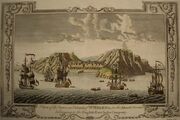
A View of the Town and Island of St Helena in the Atlantic Ocean belonging to the English East India Company, engraving, c. 1790.
In 1657, Oliver Cromwell[9] granted the English East India Company a charter to govern Saint Helena and the following year the Company decided to fortify the island and colonise it with planters. The first governor, Captain John Dutton, arrived in 1659, making Saint Helena one of Britain's oldest colonies outside North America and the Caribbean. A fort and houses were built. After the Restoration of the English monarchy in 1660, the East India Company received a Royal Charter giving it the sole right to fortify and colonise the island. The fort was renamed James Fort and the town Jamestown, in honour of the Duke of York, later James II of England.
Between January and May 1673 the Dutch East India Company forcibly took the island, before English reinforcements restored English East India Company control. The Company experienced difficulty attracting new immigrants, and unrest and rebellion fomented among the inhabitants. Ecological problems, including deforestation, soil erosion, vermin and drought, led Governor Isaac Pyke to suggest in 1715 that the population be moved to Mauritius, but this was not acted upon and the Company continued to subsidise the community because of the island's strategic location. A census in 1723 recorded 1,110 people, including 610 slaves.
Eighteenth-century governors tried to tackle the island's problems by extending tree plantations, improving fortifications, eliminating corruption, building a hospital, tackling the neglect of crops and livestock, controlling the consumption of alcohol and introducing legal reforms. From about 1770, the island enjoyed a lengthy period of prosperity. Captain James Cook visited the island in 1775 on the final leg of his second circumnavigation of the world. Saint James' Church was erected in Jamestown in 1774 and in 1791–92 Plantation House was built, and has since been the official residence of the Governor.
On leaving the University of Oxford, in 1676, Edmond Halley visited Saint Helena and set up an observatory with a 24-foot-long (7.3 m) aerial telescope with the intention of studying stars from the Southern Hemisphere.[10] The site of this telescope is near Saint Mathew's Church in Hutt's Gate, in the Longwood district. The 680 m high hill there is named for him and is called Halley's Mount.
The importation of slaves was made illegal in 1792. Governor Robert Patton (1802–1807) recommended that the Company import Chinese labour to supplement the rural workforce. The labourers arrived in 1810, and their numbers reached 600 by 1818. Many were allowed to stay, and their descendents became integrated into the population. An 1814 census recorded 3,507 people on the island.
British rule (1815–1821) and Napoleon's exile[]
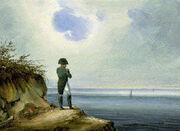
Napoleon at Saint Helena.

Longwood House, Saint Helena: site of Napoleon's captivity.
In 1815, the British government selected Saint Helena as the place of detention of Napoleon Bonaparte. He was brought to the island in October 1815; he stayed at the small Briars pavilion in the grounds of the Balcombe family's home until the building of his permanent home of Longwood House was completed, where he died on 5 May 1821. During this period, Saint Helena remained in the East India Company’s possession, but the British government met additional costs arising from guarding Napoleon. The island was strongly garrisoned with British troops, and naval ships circled the island.
The 1817 census recorded 821 white inhabitants, a garrison of 820 men on the East India Company's payroll, 1,475 men from the King's troops (infantry, engineers etc.) and 352 people as their families, 618 Chinese indentured labourers, 24 Lascars, 500 free blacks and 1,540 slaves. In total, 6,150 people on the island. In addition, the British government had sent a naval squadron under the command of a Rear-Admiral and consisting of a couple of Man O'War and several smaller vessels. These were not counted in the Census, as most of them lived on their ships. Concerning the slaves, Governor Hudson Lowe initiated their emancipation in 1818: from Christmas of that year, every new born child was considered a free person (though his parents remained slaves until their death).
British East India Company (1821–1834)[]
After Napoleon's death, the thousands of temporary visitors were soon withdrawn and the East India Company resumed full control of Saint Helena. Owing to Napoleon's praise of Saint Helena’s coffee during his exile on the island, the product enjoyed a brief popularity in Paris in the years after his death. The importation of slaves was banned in 1792. The phased emancipation of over 800 resident slaves did not take place until 1827, some six years before the British Parliament passed legislation to ban slavery in the colonies.[11]
Crown colony (1834–1981)[]
Under the provisions of the 1833 India Act, control of Saint Helena was passed from the East India Company to the British Crown, becoming a crown colony.[1] Subsequent administrative cost-cutting triggered the start of a long-term population decline whereby those who could afford to do so tended to leave the island for better opportunities elsewhere. The latter half of the 19th century saw the advent of steam ships not reliant on trade winds, as well as the diversion of Far East trade away from the traditional South Atlantic shipping lanes to a route via the Red Sea (which, prior to the building of the Suez Canal, involved a short overland section). These factors contributed to a decline in the number of ships calling at the island from 1,100 in 1855 to only 288 in 1889.
In 1840, a British naval station established to suppress the African slave trade was based on the island, and between 1840 and 1849 over 15,000 freed slaves, known as "Liberated Africans", were landed there. In 1900 and 1901, over 6,000 Boer prisoners were held on the island, and the population reached its all-time high of 9,850 in 1901.
In 1858, the French emperor Napoleon III successfully gained the possession, in the name of the French government, of Longwood House and the lands around it, last residence of Napoleon I (who died there in 1821). It is still French property, administered by a French representative and under the authority of the French Ministry of Foreign Affairs.
On 11 April 1898 American Joshua Slocum, on his famous and epic solo round the world voyage arrived at Jamestown. He departed on 20 April 1898 for the final leg of his circumnavigation having been extended hospitality from the governor, his Excellency Sir R A Standale, presented two lectures on his voyage and been invited to Longwood by the French Consular agent.
A local industry manufacturing fibre from New Zealand flax was successfully reestablished in 1907 and generated considerable income during the First World War. Ascension Island was made a dependency of Saint Helena in 1922, and Tristan da Cunha followed in 1938. During World War II, the United States built Wideawake airport on Ascension in 1942, but no military use was made of Saint Helena.
During this period, the island enjoyed increased revenues through the sale of flax, with prices peaking in 1951. However, the industry declined because of transportation costs and competition from synthetic fibres. The decision by the British Post Office to use synthetic fibres for its mailbags was a further blow, contributing to the closure of the island's flax mills in 1965.
From 1958, the Union Castle shipping line gradually reduced its service calls to the island. Curnow Shipping, based in Avonmouth, replaced the Union-Castle Line mailship service in 1977, using the RMS (Royal Mail Ship) St Helena.
1981 to present[]
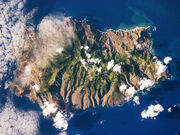
Saint Helena seen from space (photo is oriented with south-east towards the top).
The British Nationality Act 1981 reclassified Saint Helena and the other Crown colonies as British Dependent Territories. The islanders lost their status as "Citizens of the United Kingdom and Colonies" and thus lost the right of abode in Britain. For the next 20 years, many could find only low-paid work with the island government, and the only available overseas employment was on the Falkland Islands and Ascension Island. The Development and Economic Planning Department, which still operates, was formed in 1988 to contribute to raising the living standards of the people of Saint Helena.
In 1989, Prince Andrew launched the replacement RMS St Helena to serve the island; the vessel was specially built for the Cardiff–Cape Town route and features a mixed cargo/passenger layout.
The Saint Helena Constitution took effect in 1989 and provided that the island would be governed by a Governor and Commander-in-Chief, and an elected Executive and Legislative Council. In 2002, the British Overseas Territories Act restored full passports to the islanders, and renamed the Dependent Territories (including Saint Helena) the British Overseas Territories. In 2009, Saint Helena and its two territories received equal status under a new constitution, and the British Overseas Territory was renamed Saint Helena, Ascension and Tristan da Cunha.
The UK government has invested £700m in the construction of the island's airport. This is expected to help the island towards self-sufficiency and encourage economic development, in turn reducing dependence on British government aid. The airport is also expected to open the tourism industry, with up to 30,000 visitors expected annually. The airport is projected to be ready by 2015. [12]
Geography, flora and fauna[]
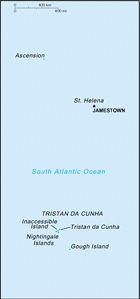
Relative locations of Saint Helena, Ascension Island and Tristan da Cunha.

Map of Saint Helena, including its future airport.
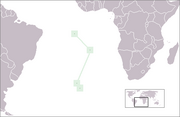
Positions (north to south) of Ascension Island, Saint Helena and Tristan da Cunha in the South Atlantic Ocean.
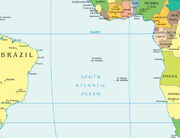
Positions of Saint Helena and Ascension Island in the South Atlantic Ocean.
Located in the South Atlantic Ocean, more than 2,000 kilometres (1,200 mi) from the nearest major landmass, Saint Helena is one of the most remote places in the world. The nearest port on the continent is Namibe in Southern Angola, the nearest international airport the Quatro de Fevereiro Airport of Angola's capital Luanda. The island is associated with two other isolated islands in southern Atlantic, also British territories — Ascension Island about 1,300 kilometres (810 mi) to the due northwest in more equatorial waters and Tristan da Cunha, which is well outside the tropics 2,430 kilometres (1,510 mi) to the south. The island is situated in the Western Hemisphere and has the same longitude as Cornwall in the United Kingdom.
The island of Saint Helena has a total area of 122 km2 (47 sq mi), and is composed largely of rugged terrain of volcanic origin (the last volcanic eruptions occurred roughly 7 million years ago).[13] The centre is covered by forest, of which some has been planted, including the Millennium Forest project. The highland areas contain most of the island's endemic flora, fauna, insects and birds. The coastal areas are barren, covered in volcanic rock and are warmer and drier than the centre of the island. There are no native land mammals on Saint Helena, but rabbits, rats and mice have been introduced, as well as feral cats and dogs. Much of the island has been identified by BirdLife International as being important for bird conservation, especially the endemic Saint Helena Plover or Wirebird, and for seabirds breeding on the offshore islets and stacks, in the north-east and the south-west Important Bird Areas.[14]
The highest point of the island is Diana's Peak at 818 m (2,684 ft). In 1996 it became the island's first national park. In 2000 a project began to replant part of the lost Great Wood, called the Millennium Forest, and is now managed by the Saint Helena National Trust, established in 2002.
When the island was discovered, it was covered with unique indigenous vegetation, including a remarkable cabbage tree species. The flora of Saint Helena contains a high proportion of endemic species. The island's hinterland must have been a dense tropical forest but the coastal areas were probably quite green as well. The modern landscape is very different, with widespread bare rock in the lower areas, although inland it is green, mainly due to introduced vegetation. The dramatic change in landscape must be attributed to the introduction of goats and the introduction of new vegetation. As a result, the string tree (Acalypha rubrinervis) and the St Helena olive (Nesiota elliptica) are now extinct, and many of the other endemic plants are threatened with extinction.
There are several rocks and islets off the coast, including: Castle Rock, Speery Island, the Needle, Lower Black Rock, Upper Black Rock (South), Bird Island (Southwest), Black Rock, Thompson's Valley Island, Peaked Island, Egg Island, Lady's Chair, Lighter Rock (West), Long Ledge (Northwest), Shore Island, George Island, Rough Rock Island, Flat Rock (East), the Buoys, Sandy Bay Island, the Chimney, White Bird Island and Frightus Rock (Southeast), all of which are within one kilometre of the shore.
The national bird of Saint Helena is the Saint Helena Plover, known locally as the Wirebird. It appears on the coat of arms of Saint Helena and on the flag.[15]
Climate[]
The climate of Saint Helena is tropical, marine and mild, tempered by the Benguela Current and trade winds which blow almost continuously.[16][17] The climate varies noticeably across the island. Temperatures in Jamestown, on the north leeward shore, range between 21–28 °C (70–82 °F) in the summer (January to April) and 17–24 °C (63–75 °F) during the remainder of the year. The temperatures in the central areas are, on average, 5-6 °C (9-11 °F) lower.[17] Jamestown also has a very low annual rainfall, while 750–1,000 mm (30–39 in) falls per year on the higher ground and the south coast, where it is also noticeably cloudier.[18] There are weather recording stations in the Longwood and Blue Hill districts.
Biodiversity[]
Due to a high number of endemic species and genera (400 known endemic species) and an exceptional range of habitats, Saint Helena is on the United Kingdom's tentative list for future UNESCO World Heritage Sites.[19]
Administrative divisions[]

Districts of Saint Helena.
Saint Helena is divided into eight districts,[20] each with a community centre. The districts also serve as statistical subdivisions and electoral areas. The four most populated districts send two representatives each to the Legislative Council, and the remaining districts send one representative each.
| District balance |
Area[21] km2 |
Area sq mi |
Pop. 1998 |
Pop. 2008[2] |
Pop./km² 2008 |
|---|---|---|---|---|---|
| Alarm Forest | 5.9 | 2.3 | 289 | 276 | 46.8 |
| Blue Hill | 36.5 | 14.1 | 177 | 153 | 4.2 |
| Half Tree Hollow | 1.6 | 0.6 | 1,140 | 901 | 563.1 |
| Jamestown | 3.6 | 1.4 | 884 | 714 | 198.3 |
| Levelwood | 14.0 | 5.4 | 376 | 316 | 22.6 |
| Longwood | 33.4 | 12.9 | 960 | 715 | 21.4 |
| Sandy Bay | 15.3 | 5.9 | 254 | 205 | 13.4 |
| Saint Paul's | 11.4 | 4.4 | 908 | 795 | 69.7 |
| Royal Mail Ship St. Helena |
– | – | 149 | 171 | – |
| Jamestown Harbour |
– | – | 20 | 9 | – |
| Total | 121.7 | 47.0 | 5,157 | 4,255 | 35.0 |
Politics[]
Executive authority in Saint Helena is invested in Queen Elizabeth II and is exercised on her behalf by the Governor of Saint Helena. The Governor is appointed by the Queen on the advice of the British government. Defence and Foreign Affairs remain the responsibility of the United Kingdom.
There are fifteen seats in the Legislative Council of Saint Helena, a unicameral legislature. Twelve of the fifteen members are elected in elections held every four years. The other three members are the Governor and two ex officio officers. The Executive Council consists of the Governor, two ex officio officers, and six elected members of the Legislative Council appointed by the Governor. There is no elected Chief Minister, and the Governor acts as the head of government. Under proposals made in January 2013, the Executive Council would be led by a Chief Councillor who would function as the de facto head of government on the island. The Chief Councillor would be elected by the members of the Legislative Council and four other members of the Executive Council would be appointed by the Governor on advice of the Chief Councillor.[22][23]
Both Ascension Island and Tristan da Cunha have an Administrator appointed to represent the Governor of Saint Helena.
One commentator has observed that, notwithstanding the high unemployment resulting from the loss of full passports during 1981–2002, the level of loyalty to the British monarchy by the St Helena population is probably not exceeded in any other part of the world.[24] King George VI is the only reigning monarch to have visited the island. This was in 1947 when the King, accompanied by Queen Elizabeth (later the Queen Mother), Princess Elizabeth (later Queen Elizabeth II) and Princess Margaret were travelling to South Africa. Prince Philip arrived at St Helena in 1957 and then his son Prince Andrew visited as a member of the armed forces in 1984 and his sister the Princess Royal arrived in 2002.
Demographics[]
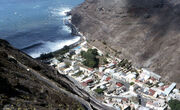
Jamestown, from above.
Saint Helena was first settled by the English in 1659, and the island presently has a population of about 4,250 inhabitants, mainly descended from people from Britain – settlers ("planters") and soldiers – and slaves who were brought there from the beginning of settlement – initially from Africa (the Cape Verde Islands, Gold Coast and west coast of Africa are mentioned in early records), then India and Madagascar. Eventually the planters felt there were too many slaves and no more were imported after 1792.
In 1840, St Helena became a provisioning station for the British West Africa Squadron,[25] preventing slavery to Brazil (mainly), and many thousands of slaves were freed on the island. These were all African, and about 500 stayed while the rest were sent on to the West Indies and Cape Town, and eventually to Sierra Leone.
Imported Chinese labourers arrived in 1810, reaching a peak of 618 in 1818, after which numbers were reduced. Only a few older men remained after the British Crown took over the government of the island from the East India Company in 1834. The majority were sent back to China, although records in the Cape suggest that they never got any further than Cape Town. There were also a very few Indian lascars who worked under the harbour master.

Jamestown, the capital of Saint Helena.
The citizens of Saint Helena hold British Overseas Territories citizenship. On 21 May 2002, full British citizenship was restored by the British Overseas Territories Act 2002.[26] See also British nationality law.
During periods of unemployment, there has been a long pattern of emigration from the island since the post-Napoleonic period. The majority of "Saints" emigrated to the UK, South Africa, and in the early years, Australia. The population has steadily declined since the late 1980s and has dropped from 5,157 at the 1998 census to 4,255 in 2008. In the past emigration was characterised by young unaccompanied persons leaving to work on long-term contracts on Ascension and the Falkland Islands, but since "Saints" were re-awarded UK citizenship in 2002, emigration to the UK by a wider range of wage-earners has accelerated due to the prospect of higher wages and better progression prospects.
Religion[]
The majority of people belong to the Anglican Communion, being members of the Diocese of St Helena, which includes Ascension Island, and which has its own Bishop residing on St Helena. The 150th Anniversary of the Diocese was celebrated in June 2009. Other Christian denominations on the island include: Roman Catholic (since 1852), Salvation Army (since 1884), Baptist (since 1845), and, in more recent times, Seventh-day Adventist (since 1949), New Apostolic, and Jehovah's Witnesses (one out of every 35 residents is one of Jehovah's Witnesses, the highest ratio in the world).[27] The Baha'i Faith has also been represented on the island since 1954.
Tristan da Cunha and Ascension[]
Tristan da Cunha, settled since 1815, has a population of fewer than three hundred inhabitants of mainly British, Irish, Italian and St Helenian descent. Christianity is the main religion, mainly Anglican and some Roman Catholic.
Ascension Island has no native inhabitants. It is a working island with a transient population of approximately 1,000, made up mainly of members of the American and British militaries, supporting civilian contractors who serve on the joint Anglo-American airbase, and members of their families (a few of whom were born on the island). There are also some Cable & Wireless and local government employees.
Economy[]
- Note: Some of the data in this section has been sourced from the Government of St Helena Sustainable Development Plan.[28]
The island had a monocrop economy until 1966, based on the cultivation and processing of New Zealand flax for rope and string. St Helena's economy is now weak, and is almost entirely sustained by aid from the British government. The public sector dominates the economy, accounting for about 50% of gross domestic product. Inflation was running at 4% in 2005. There have been increases in the cost of fuel, power and all imported goods.
The tourist industry is heavily based on the promotion of Napoleon's imprisonment. A golf course also exists and the possibility for sportfishing tourism is great. Three hotels operate on the island but since the arrival of tourists is directly linked to the arrival and departure schedule of the RMS (Royal Mail Ship), occupancy levels are very low at about 10%. Some 1,180 short- and long-term visitors arrived on the island in 2005.
Saint Helena produces what is said to be the most expensive coffee in the world. It also produces and exports Tungi Spirit, made from the fruit of the prickly or cactus pears, Opuntia ficus-indica ("Tungi" is the local St Helenian name for the plant). Ascension Island, Tristan da Cunha and Saint Helena all issue their own postage stamps which provide a significant income.
Economic statistics[]
Quoted at constant 2002 prices, GDP fell from £12 million in 1999/2000 to £11 million in 2005/6. Imports are mainly from the UK and South Africa and amounted to £6.4 million in 2004/5 (quoted on an FOB basis). Exports are much smaller, amounting to £0.2 million in 2004/5. Exports mainly comprise of fish and coffee; Philatelic sales were £0.06 million in 04/05. The limited number of visiting tourists spent about £0.4 million in 2004/05, representing a contribution to GDP of 3%.
Public expenditure rose from £10 million in 2001/02 to £12 million in 2005/06. The contribution of UK budgetary aid to total SHG government expenditure rose from £4.6 million in to £6.4 million over the same period. Wages and salaries represent about 38% of recurrent expenditure.
Unemployment levels are low (50 in 2004 compared with 342 in 1998). Employment is dominated by the public sector, the number of government positions only falling slightly from 1,163 in 2002 to 1,142 in 2006. Public sector employment is characterised by high turnover rates, mainly due to emigration. St Helena’s private sector employs approximately 45% of the employed labour force and is largely dominated by small and micro businesses with 218 private businesses employing 886 in 2004.
Household survey results suggest the % of households who spend less than £20 per week on a per capita basis fell from 27% to 8% between 2000 and 2004, implying a decline in income poverty. Nevertheless, 22% of the population claimed social security benefit in 2006/7, although most of these are aged over 60 – this sector represents 20% of the population.
Banking and currency[]
In 1821, Saul Solomon issued a token copper currency of 70,560 halfpennies Payable at St Helena by Solomon, Dickson and Taylor — presumably London partners — which circulated alongside the East India Company's local coinage until the Crown took over the Island in 1836. The coin remains readily available to collectors.
Today Saint Helena has its own currency, the Saint Helena pound which is at parity with the pound sterling. The government of Saint Helena produces its own coinage and banknotes. The Bank of Saint Helena was established on Saint Helena and Ascension Island in 2004. It has branches in Jamestown on Saint Helena, and Georgetown, Ascension Island and it took over the business of the St. Helena government savings bank and the Ascension Island Savings Bank.[29]
For more information on currency in the wider region, see the Sterling Currency in the South Atlantic and the Antarctic.
Transport[]
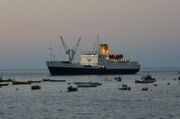
RMS St Helena in James Bay.
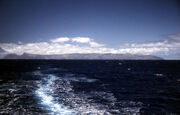
Looking back at the island from the RMS St Helena.
Saint Helena is one of the most remote islands in the world, has no commercial airports, and travel to the island is by ship only. A large military airfield is located on Ascension Island, with two Friday flights to RAF Brize Norton, England (as from September 2010). These RAF flights offer a limited number of seats to civilians. The ship RMS Saint Helena runs between St Helena and Cape Town, also visiting Ascension Island and Walvis Bay, and occasionally voyaging north to Tenerife and Portland, UK. It berths in James Bay, St Helena approximately thirty times per year.[30] The RMS Saint Helena was due for decommissioning in 2010. However, its service life has been extended indefinitely until the airstrip is completed.[31]
After a long period of rumour and consultation, the British government announced plans to construct an airport in Saint Helena in March 2005 and the airport was originally expected to be completed by 2010. However constant delays by the British government meant an approved bidder, the Italian firm Impregilo, was not chosen until 2008, and then the project was put on hold in November 2008, allegedly due to new financial pressures brought on by the credit-crunch. By January 2009, construction had not commenced and no final contracts had been signed, and Governor Andrew Gurr departed for London in an attempt to speed up the process and solve the problems.
On 22 July 2010, the British government agreed to help pay for the new airstrip using taxpayer money.[32] In November 2011 a new deal between the British government and South African company Basil Read was signed and now means the airport is proposed to open in 2015, with flights to and from South Africa.[33] However, no airline has yet shown an interest in providing services.
A minibus offers a basic service to carry people around Saint Helena, with most services designed to take people into Jamestown for a few hours on weekdays to conduct their business.
Media and communications[]
Radio[]
Radio St Helena, which started operations on Christmas Day 1967, provides a local radio service that has a range of about 100 km from the island, and also broadcasts internationally on Shortwave Radio (11092.5 kHz) on one day a year.[34] The station presents news, features and music in collaboration with its sister newspaper, the St Helena Herald. As of 2012, the station is set to go off the air permanently, giving way to a new three-channel FM station run by the St. Helena Broadcasting Corporation.[35]
Saint FM[36] provides a local radio service for the island which is also available on internet radio[37] and relayed in Ascension Island. The station is not government funded. It was launched in January 2005. It broadcasts news, features and music in collaboration with its sister newspaper, the St Helena Independent.
Online[]
St Helena Online[38] is a not-for-profit internet news service run from the UK by a former print and BBC journalist, working in partnership with Saint FM and the St Helena Independent.
Television[]
Cable & Wireless offers television for the island via three analogue terrestrial UHF channels, offering a mix of British, US, and South African programming. The first channel is a mix of entertainment programming from BBC Entertainment, the Universal Channel, and the Disney Channel, the second carries a mix of factual programming from BBC World News, National Geographic Channel, Discovery Channel, while the third carries SuperSport. The feed signal, from MultiChoice DStv in South Africa, is received by a satellite dish at Bryant's Beacon from Intelsat 7 in the Ku band.[39] Since October 2011 digital broadcasting equipment according to the DVB-T2 standard is being installed in St Helena, which will allow to increase the number of TV channels significantly.[40] The St Helena Broadcasting Corporation will broadcast television in 2014 on channel 1.
Telecommunications[]
Cable & Wireless South Atlantic Ltd provide the telecommunications service in the territory through a digital copper-based telephone network including ADSL-broadband service. In August 2011 the first fiber-optic link has been installed on the island, which connects the television receive antennas at Bryant's Beacon to the Cable & Wireless Technical Centre in the Briars. Plans are now being made for further fibre optic cable installations.[41]
A satellite ground station with a 7.6 metre satellite dish installed in 1989[42] at The Briars is the only international connection providing satellite links through Intelsat 707 to Ascension island and the United Kingdom.[43] Since all international telephone and internet communications are relying on this single satellite link both internet and telephone service are subject to sun outages. Although the South Atlantic Express submarine communications cable will pass St Helena relatively closely there are no plans to land the cable and install a relay station ashore, which could supply the population with sufficient bandwidth. As of January 2012, there is a group of supporters petitioning the UK government to meet the cost of landing the cable at St Helena.[44]
Saint Helena has the international calling code +290 which, since 2006, Tristan da Cunha shares. Telephone numbers are 4 digits long. Numbers start with 1-9, with 8xxx being reserved for Tristan da Cunha numbers and 2xxx for Jamestown.[45] Currently there is no cellular network installed in St Helena.
Internet[]
Saint Helena has a 10/3.6 Mbit/s[43] internet link via Intelsat 707 provided by Cable & Wireless South Atlantic. Serving a population of more than 4000, this single satellite link is considered inadequate in terms of bandwidth.
ADSL-broadband service is provided with maximum speeds of up to 384 KBit/s downstream and 128 KBit/s upstream offered on contract levels from lite £20 per month to gold at £120 per month.[46] There are a few public WiFi hotspots in Jamestown, which are also being operated by Cable & Wireless.[47]
On October 6, 2012, an undersea fiber optic provider, eFive, agreed to reroute a 10,000 km (6,214 mi) cable connecting Africa to South America through St. Helena after a successful lobbying campaign by A Human Right a San Francisco-based NGA working on initiatives to ensure all people are connected to the internet. Islanders have sought the assistance of the UK Foreign and Commonwealth Office in funding the £10m required to bridge the connection from a local junction box on the cable to the island. The UK Government have announced that a review of the island's economy would be required before such funding would be agreed to.[48]
Local newspapers[]
The island had two local newspapers, one of which is available on the internet. The second closed due to being unable to compete with the government-run newspaper. The St Helena Herald has been published by the partially publicly funded St Helena News Media Services (SHNMS) since 2000. The St Helena Independent[49] has been published since November 2005.
Funding[]
In October 2008, the St Helena government announced that the island’s media must choose whether they obtained revenue from government subsidies or from advertising. They could not do both. On this basis, the partly publicly subsidised Media Services, which publishes the St Helena Herald and broadcasts on Radio St Helena, would no longer be allowed to run advertisements.[50] Simultaneously, the St Helena Independent and Saint FM announced that they would need to increase advertising rates, which barely covered the cost of producing adverts.
Culture and society[]
Education[]
Education is free and compulsory between the ages of 5 and 16.[51] There are three first schools, three middle schools, and one secondary school for 11-18 year olds. The English examination system is followed. There is no tertiary education institution in Saint Helena.
Sport[]
Sports played on the island include association football, cricket, volleyball, tennis, golf, shooting sports and yachting. Saint Helena has sent teams to a number of Commonwealth Games. Saint Helena is a member of the International Island Games Association.[52] The Saint Helena cricket team made its debut in international cricket in Division Three of the African region of the World Cricket League in 2011.
The Governor's Cup is a yacht race (and the first prize) between Cape Town and Saint Helena island, held every two years in December/January; the most recent event was in December 2010. In Jamestown a timed run takes place up Jacob's Ladder every year, with people coming from all over the world to take part.
Scouting[]
There are scouting and guiding groups on Saint Helena and Ascension Island. Scouting was established on Saint Helena island in 1912.[53] Lord and Lady Baden-Powell visited the Scouts on Saint Helena on the return from their 1937 tour of Africa. The visit is described in Lord Baden-Powell's book entitled African Adventures.[54]
See also[]
- List of islands
- Manatee of Helena
- Outline of Saint Helena
- Saint Helena Police Service
References[]
- ^ a b The St Helena, Ascension and Tristan da Cunha Constitution Order 2009 "...the transfer of rule of the island to His Majesty’s Government on 22 April 1834 under the Government of India Act 1833, now called the Saint Helena Act 1833" (Schedule Preamble)
- ^ a b c http://unstats.un.org/unsd/demographic/sources/census/2010_PHC/Saint_Helena/Saint_Helena.pdf
- ^ "Constitution of St. Helena, Ascension and Tristan da Cunha". UK Archives. 2009. http://www.opsi.gov.uk/si/si2009/plain/uksi_20091751_en#sch1-pt5. Retrieved 21 July 2012.
- ^ article: Tristan da Cunha (distance)
- ^ A. H. Schulenburg, 'The discovery of St Helena: the search continues'. Wirebird: The Journal of the Friends of St Helena, Issue 24 (Spring 2002), pp. 13–19.
- ^ Duarte Leite, História dos Descobrimentos, Vol. II (Lisbon: Edições Cosmos, 1960), 206.
- ^ de Montalbodo, Paesi Nuovamente Retovati & Nuovo Mondo da Alberico Vesputio Fiorentino Intitulato (Venice: 1507)
- ^ Drake and St Helena, privately published by Robin Castell in 2005
- ^ "Historical Chronology". St. Helena Foundation. http://www.sthelena.se/history/cron.txt. Retrieved 21 July 2012.
- ^ Gazetteer - p. 7. MONUMENTS IN FRANCE - page 338
- ^ New research published on http://www.fosh.org.uk; shortened extract published in the St Helena Independent on 3 June 2011.
- ^ BBC News. "England's St Helena exiles welcome island airport project", BBC News Online, 21 April 2012. Retrieved on 21 February 2012.
- ^ Natural History of Saint Helena
- ^ "Important Bird Areas". BirdLife data zone. BirdLife International. 2012. http://www.birdlife.org. Retrieved 2012-11-09.
- ^ "Bird Watching". St Helena Tourism. http://www.sthelenatourism.com/pages/bird_watching.html. Retrieved 17 January 2011.
- ^ "St. Helena, Ascension, and Tristan da Cunha". CIA World Factbook. Central Intelligence Agency. http://www.cia.gov/library/publications/the-world-factbook/geos/sh.html. Retrieved 21 July 2012.
- ^ a b About St Helena, St Helena News Media Services
- ^ BBC Weather Centre
- ^ "Tentative Lists: St. Helena". UNESCO. 2012-01-27. http://whc.unesco.org/en/tentativelists/5675/. Retrieved 21 July 2012.
- ^ St Helena Independent, 3 October 2008 page 2
- ^ GeoHive St Helena
- ^ http://www.sainthelena.gov.sh/data/files/improving_democracy.pdf
- ^ [1]
- ^ Smallman, David L., Quincentenary, a Story of St Helena, 1502–2002; Jackson, E. L. St Helena: The Historic Island, Ward, Lock & Co, London, 1903
- ^ "CIA World Factbook". Cia.gov. https://www.cia.gov/library/publications/the-world-factbook/geos/sh.html. Retrieved 2012-12-06.
- ^ St Helena celebrates the restoration of full citizenship, Telegraph, 22 May 2002
- ^ "Jehovah's Witnesses 2011 Worldwide Report". Watch Tower Bible and Tract Society of Pennsylvania. 2012. http://www.watchtower.org/e/statistics/wholereport.htm. Retrieved 21 July 2012.
- ^ News.co.sh
- ^ The Bank of Saint Helena "About Us: History of the Bank of St. Helena". Bank of St. Helena. http://www.sainthelenabank.com/aboutus.htm#history The Bank of Saint Helena. Retrieved 21 July 2012.
- ^ "RMS St. Helena Schedule & Fares". RMS St. Helena. http://www.rms-st-helena.com/voyageschedules.php. Retrieved 21 July 2012.
- ^ Gavin Bell (07-10-2011). "RMS St. Helena: A Final Sailing from British Shores". The Telegraph. http://www.telegraph.co.uk/travel/cruises/8812951/RMS-St-Helena-a-final-sailing-from-British-shores.html. Retrieved 21 July 2012.
- ^ Daniel McElroy & Christopher Hope (2012-07-22). "Britain to pay for St. Helena airstrip backed by Lord Ashcroft". The Telegraph. http://www.telegraph.co.uk/news/worldnews/africaandindianocean/sainthelena/7905386/Britain-to-pay-for-St-Helena-airstrip-backed-by-Lord-Ashcroft.html. Retrieved 21 July 2012.
- ^ "Remote UK island colony of St Helena to get airport". BBC News. 3 November 2011. http://www.bbc.co.uk/news/uk-15578596. Retrieved 21 July 2012.
- ^ Dexter, G. (2009, October). A goal for the DX season: target ten for '10. Popular Communications, 28(2), 11-14.
- ^ Simon Pipe (2012-06-14). "Media saga takes new twist as Mike plans more radio stations". St. Helena Online. http://sthelenaonline.org/2012/06/14/media-saga-takes-new-twist-as-mike-plans-more-radio-stations/. Retrieved 21 July 2012.
- ^ "Saint FM Homepage". Saint FM. http://www.saint.fm. Retrieved 21 July 2012.
- ^ "Saint FM Live Stream". Saint FM. http://www.saint.fm/listen_live.htm. Retrieved 21 July 2012.
- ^ "Saint Helena Online". http://www.sthelenaonline.org. Retrieved 21 July 2012.
- ^ "Public Information on the Television Delivery on the KU-BAND". Cable and Wireless. Archived from the original on 2010-06-30. http://web.archive.org/web/20100630165546/http://www.cwi.sh/downloads/PubInfoTV.pdf. Retrieved 21 July 2012.
- ^ "Digital Terrestrial Television Project Progresses for C&W". St. Helena Independent. 2011-10-21. http://www.saint.fm/Independent/20111021.pdf. Retrieved 22 July 2012.
- ^ "Cable & Wireless SA Ltd First Fibre Network for St Helena". St. Helena Herald. 5 August 2011. http://www.news.co.sh/Newspapers/SHH%2020110805.pdf. Retrieved 22 July 2012.
- ^ "Cable & Wireless Carries out Major Mechanical Maintenance" The St Helena Independent Volume 1, Issue 37 Friday 21 July 2006, p. 8
- ^ a b http://liveweb.archive.org/http://www.cwi.sh/our_network.html/
- ^ Christian von der Ropp. "Connect St Helena". Connectsthelena.org. http://www.connectsthelena.org. Retrieved 2012-12-06.
- ^ World Telephone Numbering Guide Saint Helena and Tristan da Cunha
- ^ http://liveweb.archive.org/http://www.cwi.sh/broadband.html
- ^ "WiFi". Web.archive.org. 2010-06-30. Archived from the original on 2010-06-30. http://web.archive.org/web/20100630165620/http://www.cwi.sh/wifi.html. Retrieved 2012-12-06.
- ^ Dave Lee (3 January 2013). "Island community St Helena renews plea for internet cash from UK". BBC News Online. http://www.bbc.co.uk/news/technology-20899691. Retrieved 2 January 2013.
- ^ "St Helena Independent". Saint.fm. 2012-11-30. http://www.saint.fm/Independent/index.htm. Retrieved 2012-12-06.
- ^ Governor Broadcast & St Helena Independent, both on 31 October 2008
- ^ "Territories and Non-Independent Countries". 2001 Findings on the Worst Forms of Child Labor. Bureau of International Labor Affairs, U.S. Department of Labor (2002). This article incorporates text from this source, which is in the public domain.
- ^ Island Games St Helena profile
- ^ ScoutBaseUK A Scouting Timeline
- ^ "A Baden-Powell Bibliography". July 2007. http://www.scouting.milestones.btinternet.co.uk/bpbooks.htm. Retrieved 2009-07-07.
Further reading[]
- Aptroot, Andre. Lichens of St Helena, Pisces Publications, Newbury, UK, 2012, ISBN 1-874357-53-7
- Brooke, T. H., A History of the Island of St Helena from its Discovery by the Portuguese to the Year 1806, Printed for Black, Parry and Kingsbury, London, 1808
- Bruce, I. T., Thomas Buce: St Helena Postmaster and Stamp Designer, Thirty years of St Helena, Ascension and Tristan Philately, pp 7–10, 2006, ISBN 1-890454-37-0
- Cannan, Edward Churches of the South Atlantic Islands 1502–1991 ISBN 0-904614-48-4
- Chaplin, Arnold, A St Helena's Who's Who or a Directory of the Island During the Captivity of Napoleon, published by the author in 1914. This has recently been republished under the title Napoleon’s Captivity on St Helena 1815–1821, Savannah Paperback Classics, 2002, ISBN 1-902366-12-3
- Clements, B.; "St Helena:South Atlantic Fortress"; Fort, (Fortress Study Group), 2007 (35), pp75–90
- Crallan, Hugh, Island of St Helena, Listing and Preservation of Buildings of Architectural and Historic Interest, 1974
- Cross, Tony St Helena including Ascension Island and Tristan Da Cunha ISBN 0-7153-8075-3
- Dampier, William, Piracy, Turtles & Flying Foxes, 2007, Penguin Books, 2007, pp 99–104, ISBN 0-14-102541-7
- Darwin, Charles, Geological Observations on the Volcanic Islands, Chapter 4, Smith, Elder & Co., London, 1844.
- Denholm, Ken, South Atlantic Haven, a Maritime History for the Island of St Helena, published and printed by the Education Department of the Government of St Helena
- Duncan, Francis, A Description of the Island Of St Helena Containing Observations on its Singular Structure and Formation and an Account of its Climate, Natural History, and Inhabitants, London, Printed For R Phillips, 6 Bridge Street, Blackfriars, 1805
- Eriksen, Ronnie, St Helena Lifeline, Mallet & Bell Publications, Norfolk, 1994, ISBN 0-620-15055-6
- Evans, Dorothy, Schooling in the South Atlantic Islands 1661–1992, Anthony Nelson, 1994, ISBN 0-904614-51-4
- George, Barbara B. St Helena — the Chinese Connection (2002) ISBN 0189948922
- Gosse, Philip Saint Helena, 1502–1938 ISBN 0-904614-39-5
- Hakluyt, The Principal Navigations Voyages Traffiques & Discoveries of the English Nation, from the Prosperous Voyage of M. Thomas Candish esquire into the South Sea, and so around about the circumference of the whole earth, begun in the yere 1586, and finished 1588, 1598–1600, Volume XI.
- Hibbert, Edward, St Helena Postal History and Stamps, Robson Lowe Limited, London, 1979
- Holmes, Rachel, Scanty Particulars: The Scandalous Life and Astonishing Secret of James Barry, Queen Victoria's Most Eminent Military Doctor, Viking Press, 2002, ISBN 0-375-5055-63
- Jackson, E. L. St Helena: The Historic Island, Ward, Lock & Co, London, 1903
- Janisch, Hudson Ralph, Extracts from the St Helena Records, Printed and Published at the "Guardian" Office by Benjamin Grant, St Helena, 1885
- Kitching, G. C., A Handbook of St Helena Including a short History of the island Under the Crown
- Lambdon, Phil. Flowering plants and ferns of St Helena, Pisces Publications, Newbury, UK, 2012, ISBN 1-874357-52-0
- Melliss, John C. M., St Helena: A Physical, Historical and Topographical Description of the Island Including Geology, Fauna, Flora and Meteorology, L. Reeve & Co, London, 1875
- Schulenburg, A. H., 'St Helena Historiography, Philately, and the "Castella" Controversy', South Atlantic Chronicle: The Journal of the St Helena, Ascension and Tristan da Cunha Philatelic Society, Vol.XXIII, No.3, pp. 3–6, 1999
- Schulenburg, A.H., '"Island of the Blessed": Eden, Arcadia and the Picturesque in the Textualizing of St Helena', Journal of Historical Geography, Vol.29, No.4 (2003), pp. 535–53
- Schulenburg, A.H., 'St Helena: British Local History in the Context of Empire', The Local Historian, Vol.28, No.2 (1998), pp. 108–122
- Shine, Ian, Serendipity in St Helena, a Genetical and Medical Study of an isolated Community, Pergamon Press, Oxford, 1970 ISBN 0-08-012794-0
- Smallman, David L., Quincentenary, a Story of St Helena, 1502–2002 ISBN 1-872229-47-6
- Van Linschoten, Iohn Huighen, His Discours of Voyages into ye Easte & West Indies, Wolfe, London, 1598
- Weider, Ben & Hapgood, David The Murder of Napoleon (1999) ISBN 1-58348-150-8
- Wigginton, Martin. Mosses and liverworts of St Helena, Pisces Publications, Newbury, UK, 2012, ISBN 1-874357-51-3
External links[]
- The Official Government Website of Saint Helena
- Radio Saint FM (live broadcasting from Saint Helena)
- Friends of St Helena – supporting St Helena and providing information about the island since 1988
- The Saint Helena Virtual Library and Archive
- Saint Helena Island Information website
- CIA World Factbook entry on Saint Helena, Ascension, and Tristan da Cunha
Wikimedia Atlas of Saint Helena
Saint Helena travel guide from Wikivoyage
- Saint Helena Travel Guide from Travellerspoint.
- The Official Website for St Helena Tourism
- St Helena's online accommodation finder and property sales
- Webcam showing Jamestown
- The first website on St Helena — since 1995
- The St Helena Institute – Dedicated to St Helena and Dependencies research since 1997
- BBC News: Life on one of the world's most remote islands
- St Helena Association (UK)
- Saint Helena at the Open Directory Project
- Main sites, habitations and occupants of the island during Napoleon's captivity
Coordinates: Template:Saint Helena, Ascension and Tristan da Cunha
| |||||||||||||||||||||||||||||||||||||||||||||||||||||||||||||||||||||||||||||||||||||||||||||||||||||||
| This page uses content from the English language Wikipedia. The original content was at Saint Helena. The list of authors can be seen in the page history. As with this Familypedia wiki, the content of Wikipedia is available under the Creative Commons License. |


